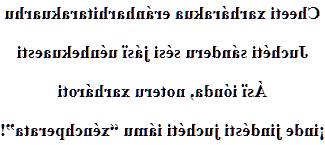Purépecha love poem
Eránharhitarhakua
Cheeti xarhárakua eránharhitarakuarhu
Juchéti sánderu sési jásï uénhekuaesti
Ásï iónda, noteru xarhároti
¡inde jindésti juchéti iámu “xénchperata”!


→ French poem ←
Purépecha language
Purépecha, formerly Tarascan, considered an isolated language, is spoken by the Purépecha in the state of Michoacán in Mexico.
Tarascan (Tarasco) is the name given to the people and the language by the Spaniards, while among themselves they call themselves Purépecha, the name which designates them today.
We divide all the dialects of P’urhépecha into two large groups: Eastern Purépecha and Western Purépecha for a total of around 130,000 speakers.
Huichu Kuakari comes from the Tanaco region, therefore from the Sierra, and tells me that his translation is in a fairly neutral variant, which can be understood by the entire community.
In any case, the different dialect forms remain sufficiently close to allow mutual understanding.
You will find the following names to designate this language and its dialects: Tarascan, Cañada de los Once Pueblos, Cantera, Purépecha de las Sierras, Cheran, Nurío, P’urhe, Purépecha de la Meseta, Tarasco, Arantepacua, Western Highland Purepecha, Angahuán, P’orhe, P’urhépecha, P’orhépecha, Purépecha del Oeste de Sierra Occidental, Pamatacuaro, Eastern Lake Purepecha, Porhé, Purépecha de la Zona Lacustre, Cuanajo, Ihuatzio, Cienega de Zacapu, San Jeronimo, Isla Janitzio.
If there have been attempts to bring together P'urhépecha and Chibcha, or Quechua, or Zuni, today the consensus is rather to consider Purepecha as an isolated language, that is to say that we are unable to compare it to another known language.
Likewise, whether it is part of the Mesoamerican linguistic area, the question remains highly debated.
In general, Purepecha speakers are bilingual with Spanish (90%), the prestigious language, because associated with a better standard of living.
As a result, since the conquest, p'urhépecha has been transformed, with both syntactic and lexical borrowings.
If P'urhépecha is a language that is still alive, particularly in the Sierra where there are the greatest number of speakers, its vitality is gradually fading.
The Purépechas
We do not know much about the origin of the Purépechas (Tarascos), except that when the Spaniards arrived they were 10 times more numerous and lived on a very large territory around the lake Pátzcuaro with Tzintzuntzan as its capital.
Their territory covered present-day Michoacán and parts of present-day neighboring states.
Before being subjugated by the Aztecs, they made their neighbors pay tribute, whom they subjugated politically. Their last king before the Spanish victory was called Tangáxoan (Caltzontzin).
Today, they live in around sixty villages and community houses, and make a living and trade in wheat, corn, forest products and crafts (pottery).